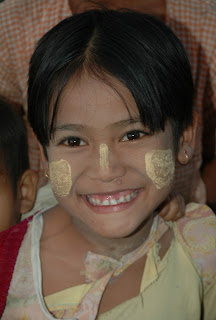Burma Bound Part 1
From time to time we at Lanna Thai Villa will lead guests on
cultural immersion tours to neighboring countries including Laos, Cambodia, Myanmar, Bali and Nepal. During the period October 22 - November 6, 2012 we will be returning for our sixth visit to Myanmar since our first in 1983. This upcoming visit will not
only include what are becoming the standard highlights but also jeep and van trips to small rural craft and farming villages as well as river excursions to explore the lifeways of people inhabiting seasonal islands in the Irrawady River. Whenever possible we like to emphasize a people to people approach in off the beaten track
contexts. The ever present smiles despite the hardships remains one of the enduring memories of Myanmar.
 |
| Cooking dinner on a sand island in the Irrawady |
 |
| Still smiling after a hard day |
 |
| Village matriarch, Taunted Village |
 |
| Youthful Grin |
This year we will follow a common circuit but with several diversions into less explored areas. Starting in the capitol Yangon our focus will be on markets and monuments as well as street life
in this city of over 4 million. Headlining our exploration will be the Shwedagon Pagoda which continues to be inextricably linked to
Myanmar's history and modern development. However, we will also be visiting numerous other pagodas which are also impressive such as the nine story tall Buddha at Koe Htat Gyi and the reclining image at Chauk Htat Gyi. A crossing of the Yangon River will provide an opportunity to witness life on the water and along the shores.
 |
| Yangon Street Scene |
 |
| Pavilion within Shwedagaon compound, Yangon |
 |
| Shwedagon at night |
 |
| Flowers for the Buddha, Shwedagon |
 |
| Boats along Yangon River shoreline, Yangon |
Flying north we will explore not only the famous site of Bagan with its thousands of monuments but also travel by jeep and van to visit
hard to reach rural villages which will provide an introduction to the lifeways of rural lowland Burmese. Boating on the Irrawady will
give us not only the opportunity to have a different perspective on the monuments of Bagan but will also provide an opportunity to explore the lifeways of people who seasonally occupy sand islands during low water stages of the river. Living in small temporary shelters people plant crops, fish and collect gravel from the river bottom.
 |
| Water "Truck" in Irrawady River at Bagan |
 | ||||||||||||||||||||||||||||||||||||||||||||||||||||||||||||||

|
Flying northeast to Mandalay we reach the commercial heart of northern Myanmar as well as its cultural and religious center of Buddhism. Here we enjoy the views from Mandalay Hill and explore rural areas taking in the Kyauk Se Elephant Festival. Our travel by boat to the giant partially constructed chedi at Mingun will provide an opportunity to view riverine commerce including people who live on bamboo rafts which float downstream to Yangon. Famous pagodas in Mandalay include the Shwenandaw Monastery noted for its intricate wood carving, the Maha Muni Pagoda which contains a Buddha image said to have been brought to life by having been embraced seven times by him and the Kyautawgyi Paya which features an 8m., 900 ton Buddha carved from a single block of marble.
 |
| Life on a bamboo raft, Irrawady River near Mandalay |
 |
| Pounding gold bar into gold leaf in Mandalay |
 |
| Unfinished chedi at Mingun |
 |
| Interlude on top of Mandalay Hill |
From Mandalay we fly southeast to the small landing strip and former wartime Japanese airfield at Heho. After a short drive we arrive at Nyaungshwe located at the north end of Inle Lake. Inle Lake is 22 km. long and 11km. wide and nestled between two parallel mountain ranges. It is home to the Intha people famed for their stilt houses and their lacustrine way of life centered on fishing, hydroponic gardening and weaving. Inle is also noted for the annual Paung Daw Oo festival wherein four sacred images are ferried over a two week period to various monasteries dotted around the lake. The images are moved on a large barge in the form of a bird or Karaweik which is drawn by over 1000 rowers dispersed among
many connected long shallow draft canoes. Along the procession route locals wait with offerings and flowers which will be presented at the stopover temples.
 |
| Inle Lake Leg Rower |
 |
| Hydroponic gardens on Inle Lake |
 |
| Traditional fishing method on Inle Lake |
 |
| Priest at Hindu temple in Nyaungshwe |
 |
| Leg Rowers pulling Karaweik Barge |
 |
| Vendor at one of the Inle floating markets |
From Nyaungshwe after a drive through rolling hills we reach Kekku. Located in the Hopong Valley and known to the resident PaO people as Kekku Myaw Daw Pagoda. The site contains over 2000 stupas probably constructed in the Pagan dynasty (1174 - 1211AD). Typically 3 to 4 meters tall the stupas made of brick and laterite are decorated with floral designs, figures of celestial beings etc.
Before returning to Yangon another excursion will take us to the famous Pindaya Caves and the former British hill station of Kalaw.
The Pindaya Caves are a Buddhist pilgrimage site. Inside the cave are over 8000 images the earliest dating to the late 18th century. Not far away in Kalaw one can see remnants of the British presence in the form of Tudor style houses and Western church buildings. On market days the Kalaw market draws tribal people from the surrounding hills which makes for a colorful and exciting experience.
 |
| Stupas at Pindaya Cave |
 |
| Buddha images inside Pindaya Cave |
 |
| Kalaw morning market |



No comments:
Post a Comment